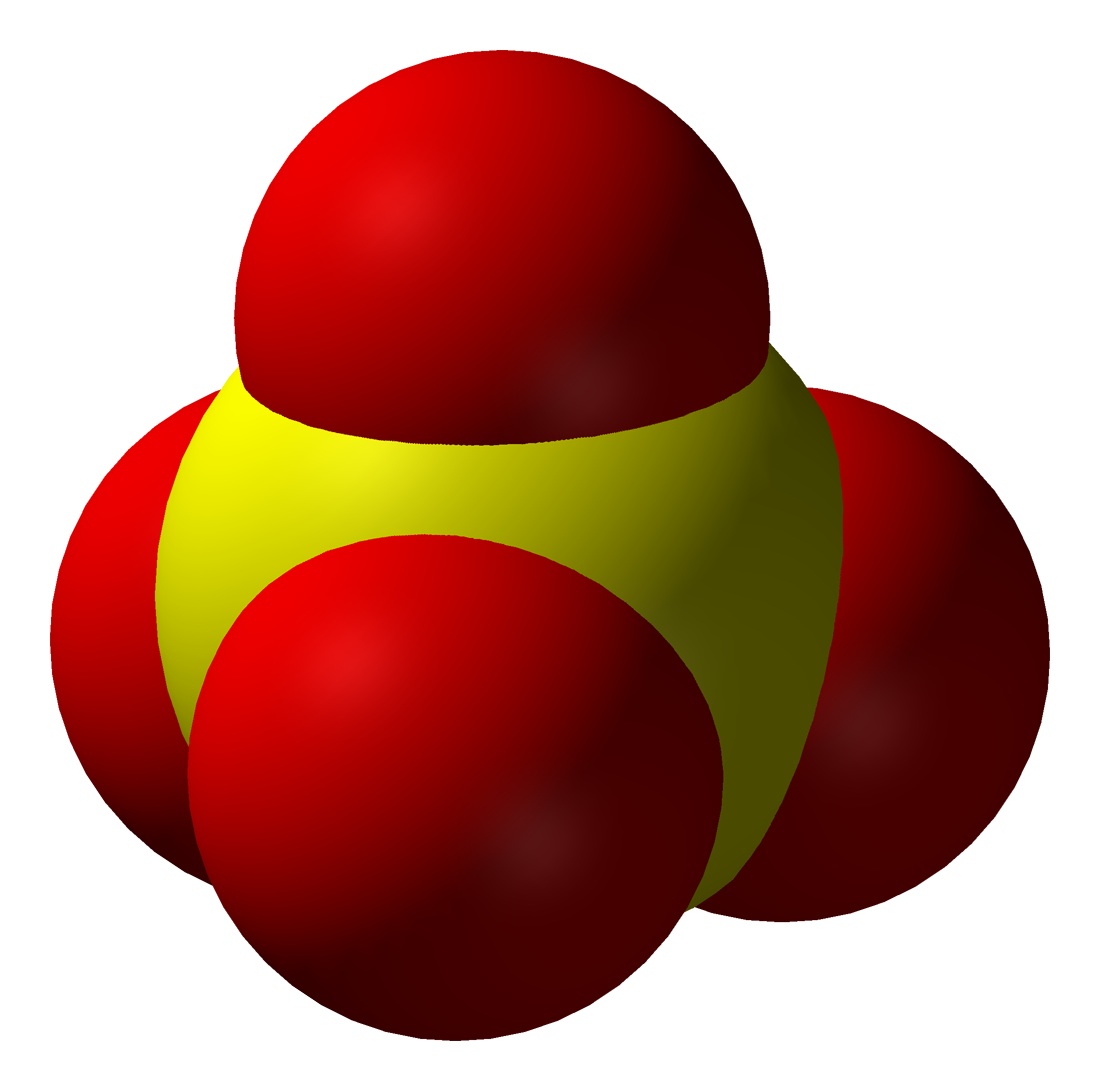Sulfate
Template:Chembox/Top
|-
| align="center" colspan="2" bgcolor="white" |

 |-
Template:Chembox/SectGeneral
Template:Chembox/Formula
Template:Chembox/MolarMass
Template:Chembox/CASNo
|-
Template:Chembox/SectStructure
Template:Chembox/MolecularShape
Template:Chembox/SectRelated
Template:Chembox/RelatedCpds
Template:Chembox/Bottom
|-
Template:Chembox/SectGeneral
Template:Chembox/Formula
Template:Chembox/MolarMass
Template:Chembox/CASNo
|-
Template:Chembox/SectStructure
Template:Chembox/MolecularShape
Template:Chembox/SectRelated
Template:Chembox/RelatedCpds
Template:Chembox/Bottom
Overview
In inorganic chemistry, a sulfate (IUPAC-recommended spelling; also sulphate in British English) is a salt of sulfuric acid.
Chemical properties
The sulfate ion is a polyatomic anion with the empirical formula SO42− and a molecular mass of 96.06 daltons; it consists of a central sulfur atom surrounded by four equivalent oxygen atoms in a tetrahedral arrangement. The sulfate ion carries a negative two charge and is the conjugate base of the bisulfate (or hydrogen sulfate) ion, HSO4−, which is the conjugate base of H2SO4, sulfuric acid. Organic sulfates, such as dimethyl sulfate, are covalent compounds and esters of sulfuric acid.
Preparation
Methods of preparing ionic sulfates include:[1]
- dissolving a metal in sulfuric acid
- reacting sulfuric acid with a metal hydroxide or oxide
- oxidizing metal sulfides or sulfites
Properties
Many examples of ionic sulfates are known, and many of these are highly soluble in water. Exceptions include calcium sulfate, strontium sulfate, and barium sulfate, which are poorly soluble. The barium derivative is useful in the gravimetric analysis of sulfate: one adds a solution of, perhaps, barium chloride to a solution containing sulfate ions. The appearance of a white precipitate, which is barium sulfate, indicates that sulfate anions are present.
The sulfate ion can act as a ligand attaching either by one oxygen (monodentate) or by two oxygens as either a chelate or a bridge.[1] An example is the neutral metal complex PtSO4P(C6H5)32 where the sulfate ion is acting as a bidentate ligand. The metal-oxygen bonds in sulfate complexes can have significant covalent character.
Structure and bonding
The S-O bond length of 149 pm is shorter than expected for a S-O single bond; for example the bond lengths in sulfuric acid are 157 pm for S-OH. The tetrahedral geometry of the sulfate ion is as predicted by VSEPR theory.
The first description of the bonding in modern terms was by Gilbert Lewis in his groundbreaking paper of 1916 where he described the bonding in terms of electron octets around each atom, i.e. no double bonds and a formal charge of 2+ on the sulfur atom.[2]
Later, Linus Pauling used valence bond theory to propose that the most significant resonance canonicals had two π bonds (see above) involving d orbitals. His reasoning was that the charge on sulfur was thus reduced, in accordance with his principle of electroneutrality.[3] The double bonding was taken by Pauling to account for the shortness of the S-O bond (149 pm).
Pauling's use of d orbitals provoked a debate on the relative importance of π bonding and bond polarity (electrostatic attraction) in causing the shortening of the S-O bond. The outcome was a broad consensus that d orbitals play a role, but are not as significant as Pauling had believed.[4][5] A widely accepted description involves pπ - dπ bonding, initially proposed by D.W.J Cruickshank, where fully occupied p orbitals on oxygen overlap with empty sulfur d orbitals (principally the dz2 and dx2-y2).[6] In this description, while there is some π character to the S-O bonds, the bond has significant ionic character. This explanation is quoted in some current textbooks.[7][1] The Pauling bonding representation for sulfate and other main group compounds with oxygen is a common way of representing the bonding in many textbooks.[7][1]
Uses
Sulfates are important in both the chemical industry and biological systems:
- The lead-acid battery typically uses sulfuric acid.
- Some anaerobic microorganisms, such as those living near deep sea thermal vents use sulfates as electron acceptors.
- Copper sulfate is a common algaecide.
- Magnesium sulfate, commonly known as Epsom salts, is used in therapeutic baths.
- Gypsum, the natural mineral form of hydrated calcium sulfate, is used to produce plaster.
- The sulfate ion is used as counter ion for some cationic drugs.
History
Some sulfates were known to alchemists. The vitriol salts, from the latin vitreolum, glassy, were so-called because they were some of the first transparent crystals known.[8] Green vitriol is ferrous sulfate heptahydrate, FeSO4·7H2O; blue vitriol is copper sulfate pentahydrate, CuSO4·5H2O and white vitriol is zinc sulfate heptahydrate, ZnSO4·7H2O. Alum, a double sulfate with the formula K2Al2(SO4)4·24H2O, figured in the development of the chemical industry.
Environmental effects
Sulfates occur as microscopic particles (aerosols) resulting from fossil fuel and biomass combustion. They increase the acidity of the atmosphere and form acid rain.
Main effects on climate
The main direct effect of sulfates on the climate involves the scattering of light, effectively increasing the Earth's albedo. This effect is moderately well understood and leads to a cooling from the negative radiative forcing of about 0.5 W/m2 relative to pre-industrial values,[9] partially offsetting the larger (about 2.4 W/m2) warming effect of greenhouse gases. The effect is strongly spatially non-uniform, being largest downstream of large industrial areas.
The first indirect effect is also known as the Twomey effect. Sulfate aerosols can act as cloud condensation nuclei and this leads to greater numbers of smaller droplets of water. Lots of smaller droplets can diffuse light more efficiently than just a few larger droplets.
The second indirect effect is the further knock-on effects of having more cloud condensation nuclei. It is proposed that these include the suppression of drizzle, increased cloud height, [10] to facilitate cloud formation at low humidities and longer cloud lifetime.[11] Sulfate may also result in changes in the particle size distribution, which can affect the clouds radiative properties in ways that are not fully understood. Chemical effects such as the dissolution of soluble gases and slightly soluble substances, surface tension depression by organic substances and accommodation coefficient changes are also included in the second indirect effect.[12]
The indirect effects probably have a cooling effect, perhaps up to 2 W/m2, although the uncertainty is very large. Sulfates are therefore implicated in global dimming, which may have acted to offset some of the effects of global warming.
Other sulfur oxoanions
| Molecular formula | Name |
|---|---|
| SO52− | Peroxomonosulfate ion |
| SO42− | Sulfate |
| SO32− | Sulfite |
| S2O82− | Peroxodisulfate |
| S2O72− | Pyrosulfate |
| S2O62− | Dithionate |
| S2O52− | Metabisulfite |
| S2O42− | Dithionite |
| S2O32− | Thiosulfate |
| S4O62− | Tetrathionate |
See also
References
- ↑ 1.0 1.1 1.2 1.3 Template:Greenwood&Earnshaw
- ↑ The Atom and the Molecule by Gilbert N. Lewis Journal of the American Chemical Society Volume 38, 1916, pages 762-786
- ↑ The modern theory of valency Linus Pauling J. Chem. Soc., 1948, 1461 - 1467, doi:10.1039/JR9480001461
- ↑ C. A. Coulson, Nature, 221, 1106 (1969)
- ↑ K. A. R. Mitchell, Chem. Rev., 69, 157 (1969)
- ↑ Cotton, F. Albert; Wilkinson, Geoffrey (1966). Advanced Inorganic Chemistry (2d Edn.). New York:Wiley.
- ↑ 7.0 7.1 Template:Cotton&Wilkinson6th
- ↑ Inorganic and Theoretical Chemistry F.Sherwood Taylor 6th Edition (1942) William Heinemann
- ↑ Figure 3: The global mean radiative forcing of the climate system for the year 2000, relative to 1750. Climate Change 2001: Working Group I: The Scientific Basis. IPCC.
- ↑ Pincus & Baker 1994
- ↑ Albrecht 1989
- ↑ Chemical Amplification (or dampening) of the Twomey Effect: Conditions derived from droplet activation theory. T.A. Rissman, A. Nenes, J.H. Seinfeld.
Template:WH Template:WS Template:Jb1
ca:Sulfat cs:Sírany da:Sulfat de:Sulfate et:Sulfaadid gl:Sulfato it:Solfato lv:Sulfāti lt:Sulfatai ms:Sulfat nl:Sulfaat no:Sulfat nn:Sulfat sk:Síran sr:Сулфат fi:Sulfaatti sv:Sulfat uk:Сульфати